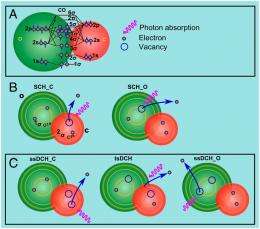October 28, 2011 feature
Bright lights, small systems: Molecular differentiation using free-electron lasers

(PhysOrg.com) -- Double-core-hole (DCH) states – in which two electrons are ejected from their positions, creating vacancies – occurring at different atomic sites are very sensitive to the chemical environment of the two holes. While differentiating between similar chemical systems using double-core-hole spectroscopy has historically been examined only theoretically, and so far there is no published work on two-site DCH states using conventional X-ray photoelectron spectroscopy based on single-photon ionization. However, a study led by Western Michigan University researchers has recently reported direct observation of double-core holes with single vacancies on two different sites produced using short, intense X-ray pulses from the Linac Coherent Light Source (LCLS) free-electron laser (FEL). Their results compare favorably with theoretical modeling, which the scientists say proves the feasibility of their approach.
Lead author Nora Berrah, working with her Western Michigan University research teams, as well as with those at Tohoku University, University of Turku, Stockholm University, Uppsala University, Sincrotrone Trieste, Stanford Linear Accelerator Center, Hiroshima University, and Institute for Molecular Science, faced several challenges in conducting the investigation. In performing direct observation of double-core holes, Berrah cites double-core-hole ionization as a powerful and useful process which can be achieved effectively with multi-photon ionization using a free-electron laser. “The challenge for us was to isolate the multi-photon effect of interest, the two-sites double core hole (tsDCH), from other multi-photon effects or from the many single photon effects, because the instrument and technique we used detected and displayed all electrons coming from any ionization and decay process.”
Moreover, Berrah adds, “The main challenge to observing direct double-core holes in a molecule is to have enough photons in the FEL pulse to displace the two innermost electrons from each of the atoms that form the molecule. This effect needs to be achieved very fast – within a few femtoseconds (fs), or quadrillionths of a second – and certainly before the holes have a chance to refill via the Auger process, with the outer electrons of the atoms that form the molecule.” The ultra-short pulse duration is what allowed them to bypass the Auger effect.
Berrah notes that it was rather straightforward to compare their measurements with theoretical modeling. “Plotting our experimental data against the theory demonstrates clearly the agreement,” she notes, “which is very good concerning the structures we observed. However, there are discrepancies regarding the intensity of the structures, which may be due to effects not included in the calculations. That being said, the calculations guided us very well.”
The key innovation the team developed to address these challenges, says Berrah, was demonstrating that two-sites double core holes can be measured to fingerprint molecules that are similar enough. ”Other spectroscopic techniques can’t resolve the spectral lines from similar molecules using single-core-hole ionization. We believe that this is a rebirth of electron spectroscopy for chemical analysis, or ESCA, which earned Kai Siegbahn a Nobel Prize.”
Other innovations are also possible. “The current experimental design, known as simple time-of-flight detection,” says Berrah, “has in fact already been improved by our group and used in recent experiments carried out this summer and fall at the LCLS X-FEL with an electron magnetic bottle (built at Uppsala University) which improves significantly the detection efficiency of the process. Furthermore, this new technique allows what we call covariance mapping which is similar to measuring coincidence events among many different electrons. This technique allows us to delineate every physical process cleanly and will allow us to spot new physical processes not known to us.”
Furthermore, the group’s findings have implications for future X-ray control of physical inner-shell processes. “One could achieve X-ray control in the future by deciding and choosing certain electronic decay patterns that are desirable by selecting specific ionization stage,” Berrah explains. “Right now, when we ionize matter, all electrons are emitted if the frequency and intensity are sufficient. However, with FELs, if we decided for example to only make hollow matter, then choosing very short pulse duration – that is, shorter than the Auger decay of the atoms of interest in the molecule – and very intense pulses, would allow us to ionize only the two-K shell, or innermost shell, electrons.”
This hollow matter has benefits, in addition to demonstrating the existence of new exotic matter. Hollow matter is transparent to X-rays since after the ionization of the two innermost electrons, the pulse is over and no ionization is possible. This effect can be used in scattering of biological matter, which allows taking a snapshot of proteins or viruses whose structure is unknown (and can't be obtained using synchrotrons because they can't crystallize) without distorting or destroying them before their image is obtained.
Moving forward, Berrah states that they need to analyze the data taken with the new electron magnetic bottle to know what new physical or chemical processes could be determined with their new methodology. In addition, Berrah concludes, a United States (Western Michigan University- Linac Coherent Light Source, Stanford Linear Accelerator Center) / German (Max Planck Society) collaboration is building sophisticated instrumentation to use fully the X-FEL. “One of the instruments will allow us to conduct X-ray pump-X-ray probe experiments on matter to understand how bonds are broken and how they are formed in real time. These time-resolved experiments with either optical lasers or the X-FEL are the next most powerful means to understand, in real time, how matter responds to X-ray radiation.”
More information: Double-core-hole spectroscopy for chemical analysis with an intense X-ray femtosecond laser, Published online before print October 3, 2011, PNAS October 11, 2011 vol. 108 no. 41 16912-16915, doi:10.1073/pnas.1111380108
Copyright 2011 PhysOrg.com.
All rights reserved. This material may not be published, broadcast, rewritten or redistributed in whole or part without the express written permission of PhysOrg.com.



















